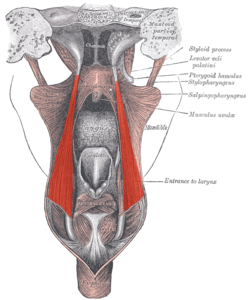| Salpingopharyngeus muscle | |
|---|---|
 Dissection of the muscles of the palate from behind. | |
| Details | |
| Origin | lower part of the cartilage of the auditory tube |
| Insertion | fibers pass downward and blend with the palatopharyngeus muscle to the upper border thyroid cartilage, blending with constrictor fibers |
| Artery | ascending pharyngeal artery |
| Nerve | vagus nerve (CN X) |
| Actions | assists in elevating pharynx, pulls on torus tubarius to pressure equalize middle ear |
| Identifiers | |
| Latin | musculus salpingopharyngeus |
| TA98 | A05.3.01.115 |
| TA2 | 2191 |
| FMA | 46665 |
| Anatomical terms of muscle | |
The salpingopharyngeus muscle is a muscle of the pharynx. It arises from the lower part of the cartilage of the Eustachian tube, [1] and inserts into the palatopharyngeus muscle by blending with its posterior fasciculus. It is innervated by vagus nerve (cranial nerve X) via the pharyngeal plexus. It raises the pharynx and larynx during deglutition (swallowing) and laterally draws the pharyngeal walls up. It opens the pharyngeal orifice of the Eustachian tube during swallowing to allow for the equalization of pressure between it and the pharynx.
Structure
The salpingopharyngeus is a very slender muscle. [1] It passes inferior-ward from its origin to its insertion [1] [2] within the salpingopharyngeal fold. [3]
Origin
The salpingopharyngeus muscle arises from the inferior portion of the cartilaginous part of the pharyngotympanic tube near its pharyngeal opening. [2] Its origin creates the posterior welt of the torus tubarius. [4]
Insertion
It ends distally by blending with the palatopharyngeus muscle. [2]
Innervation
The salpingopharyngeus receives motor innervation from the pharyngeal plexus of the vagus nerve. [2]
Blood supply
The salpingopharyngeus muscle receives arterial supply from the ascending palatine artery, greater palatine artery, and the pharyngeal branch of the ascending pharyngeal artery. [2]
Variation
The salpingopharyngeus muscle is absent in about 40% of individuals. It is more common in thin individuals. [5]
Function
The salpingopharyngeus muscle raises the pharynx and larynx during deglutition (swallowing) and laterally draws the pharyngeal walls up. [6] Unusually, it is relaxed during deglutition, but contracts at all other times. [6] It opens the pharyngeal orifice of the Eustachian tube during swallowing allowing for the equalization of pressure between the it and the pharynx.[ citation needed]
See also
Additional images
References
![]() This article incorporates text in the
public domain from
page 1143 of the 20th edition of
Gray's Anatomy (1918)
This article incorporates text in the
public domain from
page 1143 of the 20th edition of
Gray's Anatomy (1918)
- ^ a b c Sinnatamby, Chummy (2011). Last's Anatomy (12th ed.). Elsevier Australia. p. 385. ISBN 978-0-7295-3752-0.
- ^
a
b
c
d
e Standring, Susan (2020).
Gray's Anatomy: The Anatomical Basis of Clinical Practice (42nd ed.). New York. p. 711.
ISBN
978-0-7020-7707-4.
OCLC
1201341621.
{{ cite book}}: CS1 maint: location missing publisher ( link) -
^ Standring, Susan (2020).
Gray's Anatomy: The Anatomical Basis of Clinical Practice (42nd ed.). New York. p. 711.
ISBN
978-0-7020-7707-4.
OCLC
1201341621.
{{ cite book}}: CS1 maint: location missing publisher ( link) - ^ Simkins, Cleveland S. (1943). "Functional Anatomy of the Eustachian Tube". Archives of Otolaryngology–Head & Neck Surgery. 38 (5): 476–84. doi: 10.1001/archotol.1943.00670040495009.
- ^ Albahout, Khaled S.; Lopez, Richard A. (2022), "Anatomy, Head and Neck, Pharynx", StatPearls, Treasure Island (FL): StatPearls Publishing, PMID 31334991, retrieved 2023-01-12
- ^ a b Guindi, G. M.; Charia, K. K. C. (1980-11-01). "A reappraisal of the salpingo-pharyngeus muscle". Archives of Oto-Rhino-Laryngology. 229 (2): 135–141. doi: 10.1007/BF00454236. ISSN 1434-4726. PMID 7458769. S2CID 3126653.

